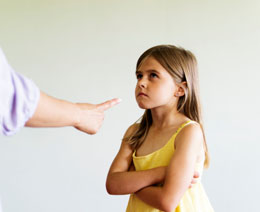
Types of Behavioral Problems in Children
What makes these disorders difficult to diagnose is that many of the symptoms are common. Nevertheless, if a child displays a few of the symptoms over quite some period of time and doesn’t seem amenable to any of the tactics that you as a parent resort to, then maybe you should consider one of the following behavior disorders in toddlers:
Oppositional Defiant Disorder
This disorder occurs twice as often in boys than in girls, and it is believed that almost 10% of children below 12 years of age suffer from oppositional defiant disorder (ODD). The common symptoms are:
- Short tempered and irritable
- Throwing temper tantrums frequently
- Arguing frequently with adults, more with those he is more familiar with, like parents
- Breaking rules
- Annoying adults deliberately
- Low self-esteem
- Blaming others for wrong actions
Conduct Disorder
Children with conduct disorders (CD) show no respect for rules. They are usually the ones that are branded as the ‘bad kids’. Those as young as 10 years old can also suffer from this behavioral issue. Again boys show a greater tendency of suffering from CD than girls. This behavior problem in children can be identified by the following traits.
- Disregard for rules or authority
- Tendency of picking up physical fights and use of weapons in such fights
- Inclination towards getting addicted to drugs and alcohol at a young age
- Cruelty towards animals
- Lack of empathy towards others
- Criminal behavior, like stealing, hurting others, vandalism, etc.
Attention Deficit Hyperactivity Disorder
As the name suggests, children suffering from attention deficit hyperactivity disorder have problems in maintaining an attention span long enough, as others their age are expected to. The attention deficit disorder symptoms are very common in children who do not suffer from this disorder as well. However, those who have this behavior disorder of childhood show these symptoms in greater severity. Again boys outnumber girls in being affected by this behavior problem. Common traits are:
- Inattention: It is marked by short attention span, difficulty in listening to others, and attending to details. These kids are forgetful and easily distracted. They lack organizational and study skills generally expected out of kids their age.
- Impulsive Behavior: Behavior of ADHD kids in the classroom is marked by inability to wait for their turn. They blurt out answers in class even when not asked to and often interrupt others.
- Hyperactivity: They find it difficult to sit in one place for long. They can’t be engaged in quiet activities. Even while sitting on their seats, they keep fidgeting and seem restless.
Treatment
If behavior problems are not dealt with on time, then the problem may escalate and cause the child to develop a dysfunctional personality when he/she grows up. The treatment is multifaceted. While some medication may be prescribed by the physician to balance chemicals in the brain that would help overcome some children behavior disorders, training parents how to deal with children with behavioral problems is equally important.
Cognitive behavioral therapy, functional family therapy in which the whole family is taught how to treat such a child may be resorted to. However, parents have the most important role to play in helping their children deal with their disorder. Besides all the therapies and treatments, parents should use positive behavior modification techniques for children by encouraging them to change their behavior. Parents should be patient but firm in reinforcing correct behavior in their little ones. While looking for help to diagnose and treat behavior problems in children, parents should seek the help of a pediatrician, child psychologist, and/or child psychiatrist.
The cause of behavior disorders in children still isn’t clearly understood although research suggest brain injury, trauma, and child abuse. Some also cite genetics as the reason behind behavior disorder in children. However, timely diagnosis and treatment are crucial in dealing with the disorders.

